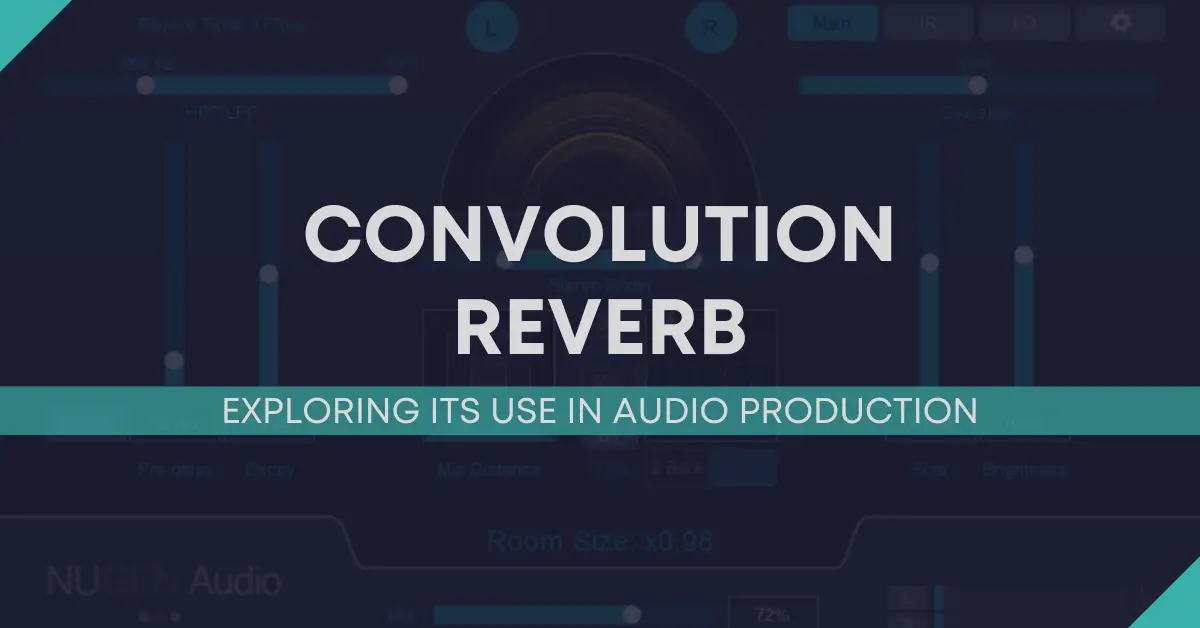
In audio production, you have an array of tools at your disposal, each designed to enhance and breathe life into your mixes. Among these, convolution reverb stands as a testament to technological sophistication within sound design. This type of reverb plugin isn't your garden-variety effect; it's a powerful space designer that employs actual audio files known as impulse responses (IR) to emit extraordinary realism within your projects. As you strive to achieve a sound that resonates with the palpable acoustics of real-world spaces, convolution reverb can transport your audio to the halls of famed venues or the intimacy of quirky, offbeat locations. To learn more about this amazing reverb, read on!
Convolution reverb is a popular mixing tool, transforming your tracks by infusing them with the essence of real space. At its core, convolution reverb is about authentically replicating the acoustics of various environments, giving life to the sounds within your mix.
Imagine capturing the acoustic soul of any location—from the resonant chambers of grand cathedrals to the intimate corners of a home studio. Convolution reverb makes this possible by utilizing impulse responses (IRs), which are audio snapshots of the reverb tail of these spaces. This innovative technique allows a plugin to apply the complex reflection and reverberation patterns to an input signal, effectively transporting your audio into brand-new landscapes of sound.
An Impulse Response, or IR, is the linchpin in creating the distinctive characteristics of convolution reverb. These audio recordings are precision-crafted echoes from an impulse—like a snap or a blast—executed within a location. These IRs encapsulate the full spectrum reflection and reverberation inherent to the space where they were recorded. Plugin libraries like those in Audio Ease Altiverb are brimming with IRs from a plethora of spaces, offering an expansive palette to paint your sonic landscape.
Unlike algorithmic reverbs that craft their effects from mathematical algorithms, convolution reverbs don't synthesize their acoustic profiles—they borrow from reality. The outcome is a reverb that doesn't just mimic a real setting; it embodies it. Where algorithmic reverbs offer flexibility and control over the reverb parameters, convolution reverbs provide a depth and authenticity that comes from their audio DNA, directly cloned from the IRs of actual locales.
Related Article: Types Of Reverb Explained: From Plate To Hall And Beyond

Imagine you are inside a sprawling cathedral, standing solemnly as a single snap resonates through the vast expanse. You're not just hearing a noise; you're witnessing the creation of an impulse response, a sonic snapshot of a room's acoustic character. This is the first step in fabricating the authentic soundscapes that convolution reverb provides.
With a precision microphone at the ready, sound engineers capture the reflections and resonance unique to real space. These reflected sounds, rich with the space's signature reverb tail, are distilled into an audio file that maps the acoustic fingerprint of a location.
At the heart of the convolution reverb's magic lies the impulse response, an intricate audio profile that offers the power to recreate a sonic experience when applied to an input signal. The following list details the steps your audio takes on its journey from a single, dry signal to a full-bodied, reverberating experience:

By harnessing the power of real-world acoustic profiles, convolution reverb enables your work to resonate with listeners in a way that's both intimate and lifelike. No longer do you need to rely on synthetic sounds to achieve the ambiance and decay you're after—convolution reverb invites you to tweak and adjust audio with precision, crafting realistic spaces that enhance every project.
Film and video game developers prize convolution reverb for its ability to create immersive environments that transport viewers or players into other realms. The reflection and resonance characteristic of a specific location can be convincingly replicated, providing audio that complements the visual narrative seamlessly.
Music producers utilize convolution reverb to enrich their sound with depth and warmth. Components like the reverb tail and decay are crucial in bringing instruments like guitars and vocals to life. By recreating spaces revered for their acoustic charm, artists achieve a sound quality that resonates on a deeper level.
In sound design, the impact of convolution reverb extends beyond simple audio enhancement. It provides a breadth of auditory cues that give life to even the most mundane of sounds. Through the power to mirror real-world spaces' acoustics precisely, it brings an unrivaled realistic space element to your creative output, distinguishing it in a crowded industry.
As an audio engineer or sound designer, your quest for realism and depth in audio mixes can lead you on a journey through various convolution reverb plugins. These tools are crucial in achieving the desired ambience and spatial effects that bring a mix to life. Let's explore some of the best convolution reverb plugins that can become staples in your audio toolbox.
Known for its vast library of impulse responses,Audio Ease Altiverb offers you an extensive range of options from iconic concert halls to secret studios. Providing you with both stereo and surround sound capabilities, Altiverb caters to the needs of today's audio professionals. Its intuitive interface allows for efficient modulation and tweaking, ensuring that you achieve the perfect reverberation for your tracks.
Revolver Convolution Reverb Native v7 stands out for its hybrid approach, combining the best of both convolution and algorithmic reverbs. Its powerful processing allows you to blend natural impulses with synthetic modulation, offering a unique level of control for your stereo and multichannel projects. This plugin is an excellent choice for sound designers seeking versatility without compromising on quality.
Distinguished by its re-synthesis technology, Nugen Audio Paragon takes convolution reverb to new heights, allowing for real-time changes in decay, room size, and brightness. Paragon offers unparalleled flexibility and realism, maintaining fidelity to the original sound spaces. It's a standout plugin for those who require precise control and are eager to push the boundaries of sonic exploration.
Related Article: The Top 5 Best Reverb Plugins for Creating Space in Your Mixes
Yes, you can create your own IRs by recording the reverberation of a space using a starter sound (like a clap or a balloon pop) and a good quality microphone. The recorded audio is then processed to be used as an IR in convolution reverb software.
Yes, although traditionally more resource-intensive, advancements in technology have made it possible to use convolution reverb in live settings. Dedicated hardware processors and optimized software have enabled its use in real-time applications.
Choosing the right IR depends on the desired reverberation character for your project. Consider the type of space you want to emulate (e.g., small room, large hall), the duration of the reverb, and any specific acoustic properties you're looking for. Experimenting with different IRs and listening critically to how they interact with your audio is key.
Convolution Reverb is versatile and can be used effectively across various genres. However, it is particularly beneficial in classical, orchestral, and acoustic music, where natural and realistic reverberation is crucial. It's also widely used in cinematic music and sound design to create atmospheric and ambient effects.
Digital reverbs, typically algorithmic in nature, create reverberation effects using mathematical algorithms to simulate the sound reflection and decay found in real environments. While they offer more flexibility and can be adjusted extensively to suit various needs, their sound is often less realistic compared to convolution reverb. Convolution reverb, on the other hand, uses recordings of real spaces to produce reverberations, providing a more authentic and natural sound. However, this realism in convolution reverb comes at the cost of higher computational requirements and less versatility in adjusting the reverb characteristics post-recording.
As you've discovered, convolution reverb is not just an enhancement but a revolution in audio production. This pioneering reverb plugin endows your projects with an extraordinary degree of realism that conventional reverbs cannot match. The palpable depth and space that can be added to music productions are invaluable, while the authentic soundscapes it affords film and game sound designers are unparalleled. It's clear that this technology has become indispensable for anyone seeking to elevate their audio work.
If you found this guide helpful, please consider subscribing to our blog for more music production tips, product reviews, and buying guides. Also, you can support new content by contributing to our tip jar.
"Some of the links within this article are affiliate links. These links are from various companies such as Amazon. This means if you click on any of these links and purchase the item or service, I will receive an affiliate commission. This is at no cost to you and the money gets invested back into Audio Sorcerer LLC."